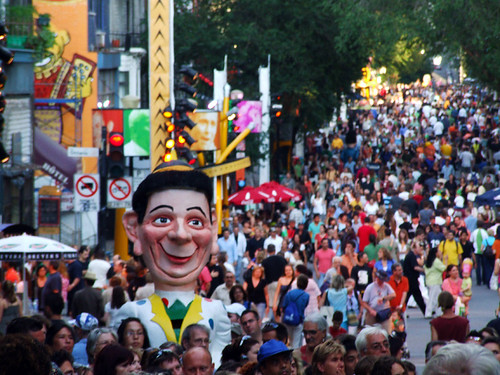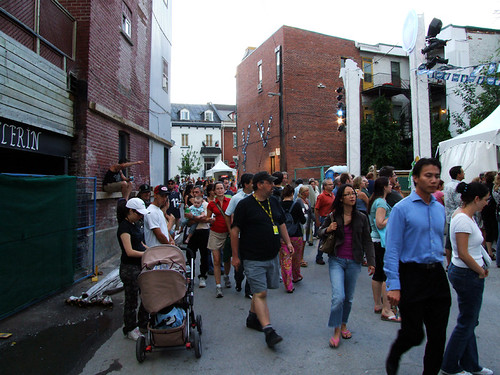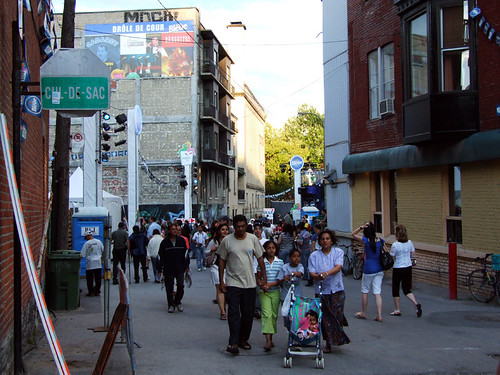Every year, I head down to Just for Laughs. Not for the comedy, but for the festival site, which takes over the entire Latin Quarter and makes brilliant use of its meandering laneways and hidden corners. For two weeks in July, the Latin Quarter becomes a mysterious village, an amiable place where crowds wander through a surreal landscape of street theatre and shadows. Outdoor cafés, bars and stages emerge in the normally quiet alleys behind St. Denis Street. Space that is normally left to cars and garbage is given over to the crowds.
Just for Laughs reveals the potential of the Latin Quarter’s urban space. The network of Victorian-era laneways that crisscrosses the neighbourhood — Joly Avenue, Terrasse St. Denis, Savoie Avenue and Place Paul-Émile-Borduas — is one of Montreal’s best-kept secrets. So why haven’t these laneways been turned into bona fide public spaces? Where are the trees, the benches, the quiet plazas in which you sit reading on a hot summer afternoon?
(Over the past couple of months, two of these alleys have been redeveloped. Place Borduas and Savoie Avenue, both of which lead to the Grande Bibliothèque, have been resurfaced with granite paving stones, though I have yet to see any benches or other types of street furniture. For the most part, the potential of these hidden streets is being squandered.)
Just for Laughs might be an exercise in urban imagination but, like too many of Montreal’s other large festivals, it is also an exercise in urban intimidation. While I am happy to see the Latin Quarter reimagined every summer, I am less thrilled to witness the temporary privatization of an entire city neighbourhood. Just for Laughs opens the streets and alleys of the Latin Quarter to the public, but it does so in the same manner as an amusement park. Access and behaviour is restricted: the festival’s security staff has the right to bar anyone from the festival site, even if it exists on public space.
For most people, this is no problem. They open their bags for a brief visual inspection and head merrily on their way. But what about those who live within the area taken over by Just for Laughs? Last week, La Presse reported that the roughly 1,700 residents of the Habitations Jeanne-Mance, a diverse public housing project that is home to a large Bengali community, must wear special badges in order to gain access to their own homes. Some residents, especially elderly ones who must navigate around barriers to get to their apartment block, have complained, adding to a long-standing list of grievances that includes excessive noise.
The question of how to manage a festival’s impact on its surrounding neighbourhood is a complicated one. I’m not prepared to offer any easy answers. But I do think that Montreal can learn from Just for Laughs’ innovative use of urban space while avoiding the kind of semi-privatization of public space it entails. In its own strange way, Just for Laugh shows us how to make good use of the Latin Quarter while reminding us not to exclude the broader community, including the residents of the Habitations Jeanne-Mance next door.
Joly Avenue is taken over by pedestrians. Stages, concessions and open-air bars have been set up in the alley.




One comment
Great post, Chris! We cross-posted it onto the Wire to generate some interest in MOntreal public space issues. We’ll do this over the course of practising.